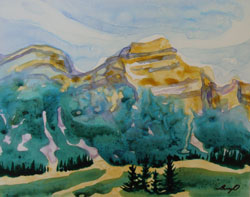Not Doing Dishes
I don’t invest in expensive palettes. I’m very happy with a piece of white cardboard that has been covered with wax paper. Two gobs of that sticky stuff that they use to hold posters onto the wall, placed on the back of the cardboard, holds the wax paper in place. The disadvantage is, you can’t judge the value (how light or dark a colour is) by pulling it out over the palette with your brush. It beads up. This is not an issue when using thicker acrylic paint or oils – only for watercolour or fluid acrylics. My workaround is to have a scrap piece of watercolour paper nearby to try the colour on before putting it onto the painting. When my palette gets too messed up to work with any longer, I simply peel off the wax paper, throw it out, and put a fresh piece on. With this method, I never have to wash a palette!


